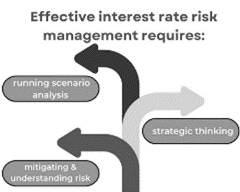By Aaron Martini, CTP, Director of ALM Services
Since the Fed began increasing the fed funds rate 11 months ago, credit unions across the country have been heavily impacted by the rapid ascent of interest rates. Credit unions experienced some benefits to the rise in rates, but challenges emerged as well. One of the greatest challenges surfaced in the NCUA Net Economic Value Supervisory Test, which indicated that many credit unions were in the “high” risk category due to rising rates increasing risk across the board. Therefore, it is no surprise that interest rate risk (IRR) tops the list of NCUA’s 2023 Supervisory Priorities..
The pitfalls of high risk
 From an operational standpoint, a high-risk classification does restrict some credit unions. On the extreme side, some credit unions had to develop and enact de-risking plans. On the more moderate side, they simply could not operate with the same freedom and flexibility they had before. The addition of long-term assets was deterred, which limited credit unions’ ability to append long-term risk at more attractive yields.
From an operational standpoint, a high-risk classification does restrict some credit unions. On the extreme side, some credit unions had to develop and enact de-risking plans. On the more moderate side, they simply could not operate with the same freedom and flexibility they had before. The addition of long-term assets was deterred, which limited credit unions’ ability to append long-term risk at more attractive yields.
Several factors came together simultaneously that caused the heightened interest rate risk exposure. One factor was the swift deposit growth brought about by the COVID-19 government stimulus packages, which placed pressure on net worth ratios. The massive influx of funds (at a time when large parts of the economy were shut down) meant credit unions did not have attractive options to lend these funds in any meaningful way. Rates were low and inflation was not a concern. This led to the next pressure point. Some credit unions needed earnings to lift ratios, so they stepped further out on the investment curve than they otherwise would have to capture a little more yield. The trade-off was considerably more duration.
In the first quarter of 2022, we learned that inflation was no longer “transitory,” and the markets responded in kind by quickly raising interest rates. In the final three quarters of 2022, loans were up 15.9%. New auto loans grew 19.9%, first lien mortgages grew 12% and second lien mortgages grew 35%. As a result, the amount held in cash and short-term investments was nearly cut in half from its level at the end of 2020, and borrowings practically doubled.
The challenges of interest rate risk for credit unions
The culmination of these events set up an elementary example of risk monitoring that is the foundation of interest rate risk (IRR).
-
Many asset prices are distressed due to the rapid elevation in market rates.
-
Liquidity has evaporated due to extension of assets and below-market loan pricing.
-
Inexpensive funding that flooded in is now retreating.
This creates challenges for credit unions if:
-
Funding is needed to maintain asset levels that cannot be reduced without equity loss.
-
Asset yields are too low to allow for funding costs to rise without equity erosion.
Sadly, more than a few executives find themselves facing this challenge. Inexpensive funding in deposit accounts is receding, with share drafts down 1.3%, regular shares down 4% and money markets down 6.5% in the past three quarters. Meanwhile, high-cost competitive certificates have risen 23.1%.
In this environment, it’s more important than ever to take the NCUA’s supervisory priorities at face value. Your IRR program should focus on these four key risk management and control activities:
-
Key assumptions and related data sets are reasonable and well documented.
-
The credit union’s overall level of IRR exposure is properly measured and controlled.
-
Results are communicated to decision-makers and the board of directors.
-
Proactive action is taken to remain within safe and sound policy limits.
If credit unions find themselves struggling based on the two scenarios mentioned above, it’s time to concentrate on liquidity management and maintaining positive earnings. It’s all about strategy: watching deposit outflow like a hawk, ensuring you retain member deposits when they present you the opportunity to match CD rates, and slowly elevating non-maturity deposit rates as asset yields allow.
Why interest rate risk is your top supervisory priority
It’s easy to play “Monday morning quarterback” and find fault with past decisions. The point of listing interest rate risk as the top supervisory priority this year is to illuminate a pathway to success. Effective interest rate risk management is not just about mitigating and understanding risk; it is about strategic thinking and running scenario analysis to determine outcomes before we live the reality. Then we can plan for it, pivot, if necessary, and ensure success for our institutions and members. Instead of looking at IRR as a regulatory mandate, see it as the key to leading your team to victory.
A qualified and dependable Asset/Liability Management (ALM) team can help your credit union evaluate and mitigate interest rate risk. Choosing an ALM team with flexible and customizable solutions can ensure your credit union is carefully evaluated according to its specific needs.
Contact the Catalyst Corporate ALM team today.